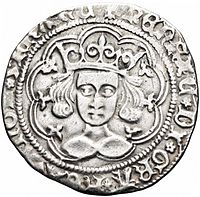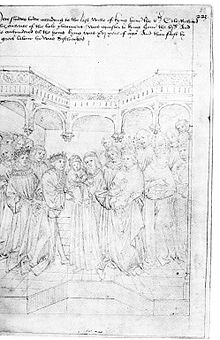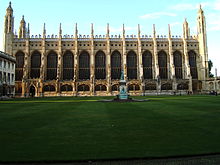- Henry VI of England
-
This article is about the historical king. For the plays by Shakespeare, see Henry VI, Part 1, Part 2, and Part 3.
Henry VI 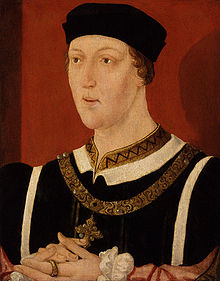
King of England
(first time; more...)Reign 31 August 1422 – 4 March 1461 Coronation 6 November 1429 Predecessor Henry V Successor Edward IV Regent John, 1st Duke of Bedford
Humphrey, Duke of Gloucester
Henry Beaufort
Richard Plantagenet, 3rd Duke of YorkKing of France
(disputed)Reign 21 October 1422 – 19 October 1453 Coronation 16 December 1431 Predecessor Charles VI Successor Charles VII King of England
(second time)Reign 30 October 1470 – 11 April 1471 Predecessor Edward IV Successor Edward IV Consort Margaret of Anjou Issue Edward of Westminster, Prince of Wales House House of Lancaster Father Henry V Mother Catherine of Valois Born 6 December 1421
Windsor Castle, BerkshireDied 21 May 1471 (aged 49)
Tower of London, LondonBurial Windsor Castle, Berkshire Signature 
Henry VI (6 December 1421 – 21 May 1471) was King of England from 1422 to 1461 and again from 1470 to 1471, and disputed King of France from 1422 to 1453. Until 1437, his realm was governed by regents. Contemporaneous accounts described him as peaceful and pious, not suited for the violent dynastic civil wars, known as the Wars of the Roses, which were to commence during his reign. His periods of insanity and his inherent benevolence eventually required his wife, Margaret of Anjou, to assume control of his kingdom, which contributed to his own downfall, the collapse of the House of Lancaster, and the rise of the House of York.[1]
Child King
Main article: The Dual-Monarchy of England and FranceHenry was the only child and heir of King Henry V of England. He was born on 6 December 1421 at Windsor, and succeeded to the throne at the age of nine months as King of England on 31 August 1422 when his father died, thus making him the youngest person ever to succeed to the English throne. Two months later, on 21 October 1422, he became King of France upon his grandfather Charles VI's death in agreement with the Treaty of Troyes in 1420. His mother, Catherine of Valois, was then 20 years old and, as Charles VI's daughter, was viewed with considerable suspicion by English nobles and prevented from having a full role in her son's upbringing.
On 28 September 1423, the nobles swore loyalty to Henry VI. They summoned Parliament in the King's name and established a regency council until the King should come of age. One of Henry V's surviving brothers, John, Duke of Bedford, was appointed senior regent of the realm and was in charge of the ongoing war in France. During Bedford's absence, the government of England was headed by Henry V's other surviving brother, Humphrey, Duke of Gloucester, who was appointed Protector and Defender of the Realm. His duties were limited to keeping the peace and summoning Parliament. Henry V's half-uncle Henry Beaufort, Bishop of Winchester (after 1426 also Cardinal), had an important place on the Council. After the Duke of Bedford died in 1435, the Duke of Gloucester claimed the Regency himself, but was contested in this by the other members of the council.
From 1428, Henry's tutor was Richard de Beauchamp, Earl of Warwick, whose father had been instrumental in the opposition to Richard II's reign.
Henry's half-brothers, Edmund and Jasper, the sons of his widowed mother's relationship with Owen Tudor, were later given earldoms. Edmund Tudor was the father of Henry Tudor, later to gain the throne as Henry VII of England.
In reaction to Charles VII Valois's coronation as French King in Reims cathedral on 17 July 1429,[2] Henry was soon crowned King of England at Westminster Abbey on 6 November 1429,[3] followed by his own coronation as King of France at Notre Dame de Paris on 16 December 1431,[4] although it wasn't until a month before his sixteenth birthday on 13 November 1437 that he obtained some measure of independent authority,[5] before he finally assumed full royal powers when he came of age.[6]
Assumption of government and French policies
Henry was declared of age in 1437, the year in which his mother died, and assumed the reins of government. Henry, shy and pious, averse to deceit and bloodshed, immediately allowed his court to be dominated by a few noble favourites who clashed on the matter of the French war.
After the death of Henry V, England had lost momentum in the Hundred Years' War, while, beginning with Joan of Arc's military victories, the Valois gained ground. The young king came to favour a policy of peace in France, and thus favoured the faction around Cardinal Beaufort and William de la Pole, Earl of Suffolk, who thought likewise, while Humphrey, Duke of Gloucester and Richard, Duke of York, who argued for a continuation of the war, were ignored.
Marriage to Margaret of Anjou
Cardinal Beaufort and the Earl of Suffolk persuaded the king that the best way of pursuing peace with France was through a marriage with Margaret of Anjou, the niece of King Charles VII's queen consort, Marie of Anjou. Henry agreed, especially when he heard reports of Margaret's stunning beauty, and sent Suffolk to negotiate with Charles, who agreed to the marriage on condition that he would not have to provide the customary dowry and instead would receive the lands of Maine and Anjou from the English. These conditions were agreed to in the Treaty of Tours, but the cession of Maine and Anjou was kept secret from parliament, as it was known that this would be hugely unpopular with the English populace. The marriage took place on 23 April 1445, one month after Margaret's fifteenth birthday.
Henry had wavered in yielding Maine and Anjou to Charles, knowing that the move was unpopular and would be opposed by the Dukes of Gloucester and York. However, Margaret was determined to make him see it through. As the treaty became public knowledge in 1446, public anger focused on Suffolk, but Henry and Margaret were determined to protect him.
The ascendancy of Suffolk and Somerset
In 1447, the King and Queen summoned the Duke of Gloucester before parliament on the charge of treason. This move was instigated by Gloucester's enemies, the Earl of Suffolk, the ageing Cardinal Beaufort and his nephew, Edmund Beaufort, Earl of Somerset. Gloucester was put in custody in Bury St Edmunds, where he died, probably of a heart attack, although there were contemporaneous rumours of poisoning, before he could be tried.
The Duke of York, now Henry's heir presumptive, was excluded from the court circle and sent to govern Ireland, while his opponents, the Earls of Suffolk and Somerset were promoted to Dukes, a title at that time still normally reserved for immediate relatives of the monarch. The new Duke of Somerset was sent to France to lead the war.
In the later years of Henry's reign, the monarchy became increasingly unpopular, due to a breakdown in law and order, corruption, the distribution of royal land to the king's court favourites, the troubled state of the crown's finances, and the steady loss of territories in France. In 1447, this unpopularity took the form of a Commons campaign against the Duke of Suffolk, who was the most unpopular of all the King's entourage and widely seen as a traitor. Henry was forced to send him into exile, but Suffolk's ship was intercepted in the English Channel. His murdered body was found on the beach at Dover.
English Royalty House of Lancaster 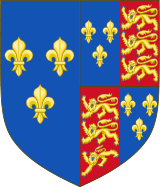
Armorial of PlantagenetHenry VI Edward, Prince of Wales In 1449, the Duke of Somerset, leading the campaign in France, reopened hostilities in Normandy, but by the autumn had been pushed back to Caen. By 1450, the French had retaken the whole province, so hard won by Henry V. Returning troops, who had often not been paid, added to the sense of lawlessness in the southern counties of England, and Jack Cade led a rebellion in Kent in 1450, calling himself "John Mortimer", apparently in sympathy with York, and setting up residence at the White Hart Inn in Southwark (the white hart had been the symbol of the deposed Richard II). Henry came to London with an army to crush the rebellion, but on finding that Cade had fled kept most of his troops behind while a small force followed the rebels and met them at Sevenoaks. The flight proved to have been tactical: Cade successfully ambushed the force in the Battle of Solefields and returned to occupy London. In the end, the rebellion achieved nothing, and London was retaken after a few days of disorder; but this was principally because of the efforts of its own residents rather than the army. At any rate the rebellion showed that feelings of discontent were running high.[7]
In 1451, the Duchy of Guyenne, held since Henry II's time, was also lost. In October 1452, an English advance in Guyenne retook Bordeaux and was having some success but by 1453, Bordeaux was lost again, leaving Calais as England's only remaining territory on the continent.
Insanity and the ascendancy of York
In 1452, the Duke of York was persuaded to return from Ireland, claim his rightful place on the council and put an end to bad government. His cause was a popular one, and he soon raised an army at Shrewsbury. The court party, meanwhile, raised their own similar-sized force in London. A stand-off took place south of London, with York presenting a list of grievances and demands to the court circle, including the arrest of Edmund Beaufort, 2nd Duke of Somerset. The king initially agreed, but Margaret intervened to prevent the arrest of Beaufort. By 1453, his influence had been restored, and York was again isolated. The court party was also strengthened by the announcement that the Queen was pregnant.
However, on hearing of the final loss of Bordeaux in August 1453, Henry slipped into a mental breakdown and became completely unaware of everything that was going on around him. This was to last for more than a year, and Henry failed even to respond to the birth of his own son and heir, who was christened Edward. Henry possibly inherited his illness from Charles VI of France, his maternal grandfather, who coped with intermittent periods of insanity over the last thirty years of his life.[8]
The Duke of York, meanwhile, had gained a very important ally, Richard Neville, Earl of Warwick, one of the most influential magnates and possibly richer than York himself. York was named regent as Protector of the Realm in 1454. The queen was excluded completely, and Edmund Beaufort was detained in the Tower of London, while many of York's supporters spread rumours that the king's child was not his, but Beaufort's. Other than that, York's months as regent were spent tackling the problem of government overspending.
Wars of the Roses
Main article: War of the RosesOn Christmas Day 1454, King Henry regained his senses. Disaffected nobles who had grown in power during Henry's reign (most importantly the Earls of Warwick and Salisbury) took matters into their own hands by backing the claims of the rival House of York, first to the Regency, and then to the throne itself.
After a violent struggle between the houses of Lancaster and York, Henry was deposed and imprisoned on 4 March 1461 by his cousin, Edward of York, who became king, as Edward IV. By this point, Henry was suffering such a bout of madness that he was apparently laughing and singing while the Second Battle of St Albans raged, which secured his release. But Edward was still able to take the throne, though he failed to capture Henry and his queen, who fled to Scotland. During the first period of Edward IV's reign, Lancastrian resistance continued mainly under the leadership of Queen Margaret and the few nobles still loyal to her in the northern counties of England and Wales. Henry, who had been safely hidden by Lancastrian allies in Scotland, Northumberland and Yorkshire was captured by King Edward in 1465 and subsequently held captive in the Tower of London.
Return to the throne
Queen Margaret, exiled in Scotland and later in France, was determined to win back the throne on behalf of her husband and son. By herself, there was little she could do. However, eventually Edward IV had a falling-out with two of his main supporters: Richard Neville, Earl of Warwick and his own younger brother George, Duke of Clarence. At the urging of King Louis XI of France they formed a secret alliance with Margaret. After marrying his daughter to Henry and Margaret's son, Edward of Westminster, Warwick returned to England, defeated the Yorkists in battle, and restored Henry VI to the throne on 30 October 1470. However, by this time, years in hiding followed by years in captivity had taken their toll on Henry. Warwick and Clarence effectively ruled in his name.[9]
Henry's return to the throne lasted less than six months. Warwick soon overreached himself by declaring war on Burgundy, whose ruler responded by giving Edward IV the assistance he needed to win back his throne by force. He won a decisive victory at the Battle of Tewkesbury on 4 May 1471, where Henry's son Edward of Westminster, Prince of Wales was killed.
Imprisonment and death
Henry was imprisoned in the Tower of London, where he died during the night of 21/22 May 1471. In all likelihood, Henry's opponents had kept him alive up to this point rather than leave the Lancasters with a far more formidable leader in Henry's son Edward. According to the Historie of the arrivall of Edward IV, an official chronicle favourable to Edward, Henry died of melancholy on hearing news of the Battle of Tewkesbury and his son's death.[10] It is widely suspected, however, that Edward IV, who was re-crowned the morning following Henry's death, had in fact ordered his murder.[11]
William Shakespeare in both Henry VI and Richard III accuses Edward's younger brother Richard of Gloucester (later to become Richard III) of the murder. His source was likely Sir Thomas More's History of Richard III, which explicitly states that Richard killed Henry; however, one contemporary source, Wakefield's Chronicle, gives the date of Henry's death as 23 May, on which Richard was known to have been away from London. In any case, as Shakespeare was writing what was acceptable to the Tudors, this information is questionable.
King Henry VI was originally buried in Chertsey Abbey; then, in 1485, his body was moved to St George's Chapel, Windsor Castle.
Legacy
Henry's one lasting achievement was his fostering of education; he founded both Eton College and King's College, Cambridge. Continuing a career of architectural patronage begun by his father, these (King's College Chapel and Eton College Chapel respectively) and most of his other architectural commissions (like his completion of his father's foundation of Syon Abbey) each consisted of a late Gothic or Perpendicular-style church with a monastic and/or educational foundation attached. Each year on the anniversary of Henry VI's death, the Provosts of Eton and King's College, Cambridge lay white lilies and roses, the floral emblems of those colleges, on the spot in the Wakefield Tower at the Tower of London where the imprisoned Henry VI was, according to tradition, murdered as he knelt at prayer.
Titles, styles, honours and arms
Arms
As Prince of Wales, Henry's arms were those of the kingdom, differenced by a label argent of three points.[12] Upon his accession, he inherited use of the arms of the kingdom and impaled them with those of France to reflect the de jure joint monarchy of France and England. Hence on (our) right, the Royal Arms of his father, Henry V, and the right, the three Fleur-de-Lys pattern of the French Royal Arms of the day.
Ancestry
Ancestors of Henry VI of EnglandPosthumous cult
Miracles were attributed to the king, and he was informally regarded as a saint and martyr, addressed particularly in cases of adversity. The cult was encouraged by Henry VII Tudor, as dynastic propaganda. A volume was compiled of the miracles attributed to him at St George's Chapel, Windsor, where Richard III had reinterred him, and at the time of Henry VIII's break with Rome, canonisation proceedings were under way.[13] Hymns to him still exist. Until the Reformation, his hat was kept by his tomb at Windsor where pilgrims would put it on to enlist Henry's aid against migraines.[14] With lessened need to legitimise Tudor rule, the cult of Henry VI faded.[15]
Shakespeare's Henry VI and after
In 1590, William Shakespeare wrote a trilogy of plays about the life of Henry VI: Henry VI, part 1, Henry VI, part 2, and Henry VI, part 3. He also appears as a ghost in Richard III. In screen adaptations of these plays he has been portrayed by James Berry in the 1911 silent short Richard III, dramatising a part of Shakespeare's play, Terry Scully in the 1960 BBC series An Age of Kings, which contained all the history plays from Richard II to Richard III, Carl Wery in the 1964 West German TV version of König Richard III, David Warner in Wars of the Roses, a 1965 filmed version of the Royal Shakespeare Company performing the three parts of Henry VI (condensed and edited into two plays, Henry VI and Edward IV) and Richard III, Peter Benson in the 1983 BBC Shakespeare versions of all three parts of Henry VI and Richard III, Paul Brennen in the 1989 film versions of the full cycle of consecutive history plays performed, for several years, by the English Shakespeare Company, Edward Jewesbury in the 1995 film version of Richard III (1995), with Ian McKellen as Richard, and James Dalesandro in the 2007 modern-day film version of Richard III.
Miles Mander portrayed him in Tower of London, a 1939 horror film loosely dramatising the rise to power of Richard III.
J.K. Rowling mentions Henry VI in her book The Tales of Beedle the Bard, in which it is implied that his advisor may have been a witch.
References
- ^ The standard modern biography is Bertram Wolff, Henry VI, London, 1981.
- ^ Lingard, John, A History of England, Vol. V, 1854, p. 90.
- ^ Lingard, p. 90.
- ^ Lingard, p. 91.
- ^ Lingard, pg. 107
- ^ Lingard, p. 108.
- ^ Sevenoaks Preservation Society: The Rising in Kent in 1450 A.D., J.K.D. Copy in Sevenoaks public library.
- ^ Charles VI, in turn, could have inherited the hereditary trait from his mother Joanna of Bourbon, who showed signs of mental illness, and her Bourbon family, where her grandfather Louis I, Duke of Bourbon, her father Peter I, Duke of Bourbon and her brother Louis II, Duke of Bourbon each had symptoms of the ailment.
- ^ Wolffe, Bertram (1981). Henry VI. London: Eyre Methuen. pp. 342–344.
- ^ John W. McKenna, "Henry VI of England and the Dual Monarchy: aspects of royal political propaganda, 1422–1432", Journal of the Warburg and Courtauld Institutes 28 (1965:145-62).
- ^ More likely is that with Prince Edward's death, there was no longer any reason to keep Henry alive. Wolffe, Bertram (1981). Henry VI. London: Eyre Methuen. pp. 347.
- ^ Marks of Cadency in the British Royal Family
- ^ Leigh Ann Craig, "Royalty, Virtue, and Adversity: The Cult of King Henry VI" Albion: A Quarterly Journal Concerned with British Studies 35.2 (Summer 2003:187–209).
- ^ Eamon Duffy, The Stripping of the Altars: Traditional Religion in England, c.1400-c.1580 1992:161
- ^ Craig 2003:189.
Henry VI of EnglandBorn: 6 December 1421 Died: 21 May 1471Regnal titles Preceded by
Henry VDuke of Aquitaine
1422–1453Annexed by France King of England
Lord of Ireland
1422–1461Succeeded by
Edward IVPreceded by
Edward IVKing of England
Lord of Ireland
1470–1471Peerage of England Vacant Title last held byHenry of MonmouthDuke of Cornwall
1421–1422Vacant Title next held byEdward of WestminsterEnglish monarchs Kingdom of the
English
886–1066- Alfred the Great
- Edward the Elder
- Ælfweard
- Athelstan the Glorious1
- Edmund the Magnificent1
- Eadred1
- Eadwig the Fair1
- Edgar the Peaceable1
- Edward the Martyr
- Æthelred the Unready
- Sweyn Forkbeard
- Edmund Ironside
- Cnut1
- Harold Harefoot
- Harthacnut
- Edward the Confessor
- Harold Godwinson
- Edgar the Ætheling
Kingdom of
England
1066–1649- William I
- William II
- Henry I
- Stephen
- Matilda
- Henry II2
- Henry the Young King
- Richard I
- John2
- Henry III2
- Edward I2
- Edward II2
- Edward III2
- Richard II2
- Henry IV2
- Henry V2
- Henry VI2
- Edward IV2
- Edward V2
- Richard III2
- Henry VII2
- Henry VIII2
- Edward VI2
- Jane2
- Mary I2 with Philip2
- Elizabeth I2
- James I3
- Charles I3
Commonwealth of
England, Scotland and Ireland
1653–1659Kingdom of
England
1660–1707- Charles II3
- James II3
- William III and Mary II3
- Anne3
1Overlord of Britain. 2Also ruler of Ireland. 3Also ruler of Scotland. 4Lord Protector.
Debatable or disputed rulers are in italics.Dukes of Normandy House of Normandy
911–1135Rollo · William I · Richard I · Richard II · Richard III · Robert I · William II · Robert II · Henry I · William IIIHouse of Blois
1135–1144House of Plantagenet
1144–1259Dukes of Cornwall Edward (1337–1376) · Richard (1376–1377) · Henry (1399–1413) · Henry (1421–1422) · Edward (1453–1471) · Edward (1470–1483) · Edward (1483–1484) · Arthur (1486–1502) · Henry (1502–1509) · Henry (1511) · Henry (1514) · Edward (1537–1547) · Henry Frederick (1603–1612) · Charles (1612–1625) · Charles (1630–1649) · James (1688–1701/2) · George (1714–1727) · Frederick (1727–1751) · George (1762–1820) · Albert Edward (1841–1901) · George (1901–1910) · Edward (1910–1936) · Charles (1952–present)
Wars of the Roses Key figures Battles Lancastrian victoriesYorkist victoriesFirst Battle of St Albans · Battle of Blore Heath · Battle of Sandwich · Battle of Northampton · Battle of Mortimer's Cross · Battle of Ferrybridge (Indecisive) · Battle of Towton · Battle of Hedgeley Moor · Battle of Hexham · Battle of Lose-coat Field · Battle of Barnet · Battle of TewkesburySee also List of French monarchs Merovingians
(481–751)Clovis I (481–511) • Chlothar I (511–561) • Charibert I (561–567) • Guntram (561–593) • Chilperic I (561–584) • Sigebert I (561–575) • Chlothar II (584–629) • Dagobert I (629–639) • Sigebert II (639–656) • Clovis II (639–657) • Chlothar III (657–673) • Theuderic III (673–691) • Clovis III (691–695) • Childebert III (695–711) • Dagobert III (711–715) • Chilperic II (715–721) • Chlothar IV (717–719) • Thierry IV (721–737) • Childeric III (737–751)Carolingians
(843–888, 898–922, 936–987)Pepin III (751–768) • Carloman I (768–771) • Charlemagne (768–814) • Louis I (814–840) • Charles I (843–877) • Louis II (877–879) • Louis III (879–882) • Carloman II (879–884) • Charles II (885–888) • Charles III (898–922) • Louis IV (936–954) • Lothair IV (954–986) • Louis V (986–987)Robertians
(888–898, 922–923)Eudes of Paris (888–898) • Robert I (922–923)Bosonids
(923–936)House of Capet
(987–1328)Hugh (987–996) • Robert II (996–1031) • Henry I (1031–1060) • Philip I (1060–1108) • Louis VI (1108–1137) • Louis VII (1137–1180) • Philip II (1180–1223) • Louis VIII (1223–1226) • Louis IX (1226–1270) • Philip III (1270–1285) • Philip IV (1285–1314) • Louis X (1314–1316) • John I (1316) • Philip V (1316–1322) • Charles IV (1322–1328)House of Valois
(1328–1498)Philip VI (1328–1350) • John II (1350–1364) • Charles V (1364–1380) • Charles VI (1380–1422) • Charles VII (1422–1461) • Louis XI (1461–1483) • Charles VIII (1483–1498)House of Valois-Orléans
(1498–1515)House of Valois-Angoulême
(1515–1589)Francis I (1515–1547) • Henry II (1547–1559) • Francis II (1559–1560) • Charles IX (1560–1574) • Henry III (1574–1589)House of Bourbon
(1589–1792)Henry IV (1589–1610) • Louis XIII (1610–1643) • Louis XIV (1643–1715) • Louis XV (1715–1774) • Louis XVI (1774–1792) • Louis XVII (claimant, 1792–1795)House of Bonaparte
First Empire (1804–1814, 1815)Napoleon I (1804–1814, 1815) • Napoleon II (1815)House of Bourbon
Bourbon Restoration
(1814, 1815–1830)House of Orléans
July Monarchy (1830–1848)Louis Philippe I (1830–1848)House of Bonaparte
Second Empire (1852–1870)Categories:- Henry VI of England
- 1421 births
- 1471 deaths
- 1471 crimes
- English monarchs
- English people of French descent
- House of Lancaster
- House of Valois
- House of Plantagenet
- People of the Hundred Years' War
- People of the Wars of the Roses
- Dukes of Cornwall
- Founders of English schools and colleges
- Murdered royalty
- Medieval child rulers
- Recipients of the Golden Rose
- Prisoners in the Tower of London
Wikimedia Foundation. 2010.

